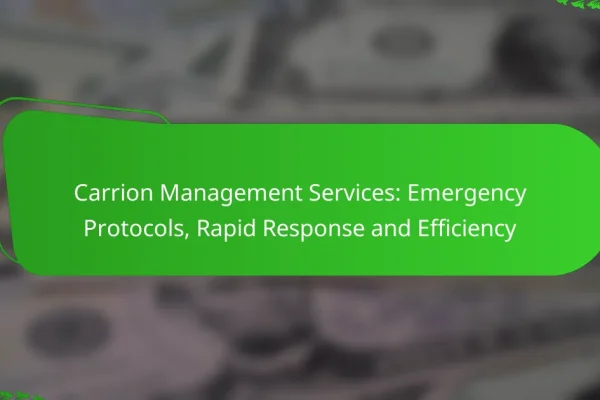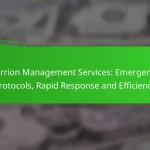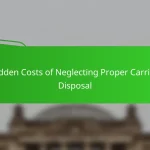Why is timely carrion removal important in urban areas?
Timely carrion removal is crucial in urban areas to prevent health risks and maintain public safety. The presence of dead animals can lead to disease transmission and attract pests, making prompt action essential for community well-being.
Prevents health hazards
Removing carrion quickly helps eliminate potential health hazards associated with decaying animals. Decomposing bodies can harbor pathogens that pose serious risks to humans and pets, including bacteria and viruses.
Urban areas often have higher population densities, which increases the likelihood of disease spread. Regular monitoring and rapid response to reports of dead animals can significantly reduce these health risks.
Reduces pest infestations
Timely removal of carrion is vital for controlling pest populations, such as rodents and insects, that are attracted to decaying matter. These pests can carry diseases and create further sanitation issues in urban environments.
By addressing carrion promptly, cities can minimize the risk of infestations, which can escalate quickly if not managed. Implementing a systematic approach for reporting and removing dead animals can help maintain a pest-free environment.
Maintains community aesthetics
Removing carrion in a timely manner helps preserve the visual appeal of urban areas. Dead animals can create unpleasant odors and an unsightly environment, which can deter residents and visitors alike.
Communities that prioritize swift carrion removal often experience higher levels of public satisfaction and pride. Establishing clear guidelines for reporting and removing dead animals can enhance overall community aesthetics and livability.
What are the best practices for carrion removal?
The best practices for carrion removal focus on prompt action, professional assistance, and proper disposal methods. Timely removal minimizes health risks and environmental impact, ensuring public safety and hygiene.
Immediate reporting to local services
When discovering carrion, the first step is to report it to local authorities or animal control services as soon as possible. This ensures that trained professionals can handle the situation appropriately, reducing the risk of disease transmission and unpleasant odors.
In many areas, you can contact local government offices or animal welfare organizations. Providing specific details about the location and type of animal can expedite the response.
Use of professional removal services
Hiring professional removal services is crucial for effective carrion management. These services are equipped with the necessary tools and expertise to safely remove and dispose of dead animals, minimizing health risks to the public.
Look for licensed and insured companies that follow local regulations regarding carrion disposal. They often have protocols in place to handle various situations, including hazardous materials, ensuring compliance with health and safety standards.
Proper disposal methods
Proper disposal methods for carrion include incineration, burial, or rendering, depending on local regulations and the size of the animal. Incineration is often preferred for its efficiency and ability to eliminate pathogens.
When burying, ensure the site is deep enough and away from water sources to prevent contamination. Always check local laws regarding burial practices to ensure compliance and avoid fines.
How does timely carrion removal impact public health?
Timely carrion removal is crucial for maintaining public health as it directly reduces the risk of disease outbreaks. When dead animals are not promptly disposed of, they can become breeding grounds for pathogens that threaten human and animal health.
Minimizes disease transmission
Removing carrion quickly minimizes the potential for disease transmission among humans and animals. Decomposing animals attract scavengers, such as rodents and insects, which can carry diseases like leptospirosis and salmonella. By ensuring swift removal, communities can significantly lower the risk of these diseases spreading.
In urban areas, where populations are dense, the impact of delayed carrion removal can be more pronounced. For instance, a single carcass left unattended can lead to increased pest populations, which may result in higher incidences of disease among residents.
Protects vulnerable populations
Timely carrion removal is essential for protecting vulnerable populations, including children, the elderly, and those with compromised immune systems. These groups are more susceptible to infections that can arise from exposure to decaying animals. Quick action in removing carrion helps safeguard their health and well-being.
Local authorities should prioritize the removal of dead animals in areas frequented by vulnerable individuals, such as parks and playgrounds. Establishing a clear protocol for reporting and addressing carrion can ensure that these populations are not exposed to unnecessary health risks.
What regulations govern carrion removal in the United States?
Carrion removal in the United States is regulated by a combination of local health department guidelines and state environmental regulations. These regulations ensure that dead animals are disposed of properly to prevent health hazards and environmental contamination.
Local health department guidelines
Local health departments typically set specific procedures for the removal of carrion within their jurisdictions. These guidelines often include requirements for reporting dead animals, designated disposal methods, and timelines for removal to minimize health risks.
For instance, many municipalities have hotlines or online reporting systems for residents to notify authorities about dead animals. Prompt removal is crucial, as decomposing carcasses can attract pests and spread diseases.
State environmental regulations
State environmental regulations provide broader frameworks for carrion disposal, focusing on ecological safety and public health. These laws may dictate acceptable disposal methods, such as incineration, burial, or rendering, and often require compliance with specific environmental standards.
For example, some states mandate that carcasses be buried at a certain depth to prevent groundwater contamination. It’s essential for individuals and businesses to be aware of their state’s regulations to avoid fines and ensure safe disposal practices.
How can residents report dead animals effectively?
Residents can report dead animals effectively by contacting local authorities or using online tools designed for this purpose. Prompt reporting helps ensure timely removal, which is crucial for public health and safety.
Contacting local animal control
To report a dead animal, residents should first contact their local animal control agency. Each municipality may have its own procedures, so it’s essential to check the specific contact information for your area. Typically, you can reach them via phone or through a dedicated email address.
When calling, provide clear details such as the location, type of animal, and any relevant landmarks. This information helps animal control respond quickly and efficiently.
Using online reporting tools
Many cities offer online reporting tools for residents to report dead animals. These platforms often allow users to submit information through a form, which can include details like the animal’s condition and exact location.
Check your local government’s website for these resources. Using online tools can expedite the reporting process and may provide tracking options to see when the animal has been removed.
What are the consequences of delayed carrion removal?
Delayed carrion removal can lead to serious public health issues and increased costs for cleanup efforts. The longer a dead animal remains in an area, the greater the risk of disease transmission and the higher the expenses associated with its removal.
Increased public health risks
When carrion is not removed promptly, it can attract scavengers and pests, which may carry diseases that can spread to humans and other animals. Common diseases associated with decaying animals include leptospirosis and salmonella, which can pose significant health threats.
To mitigate these risks, it is crucial to establish a rapid response protocol for carrion removal. Local health departments often recommend that dead animals be reported and removed within 24 hours to minimize exposure to harmful pathogens.
Higher cleanup costs
Delays in carrion removal can lead to escalating cleanup costs due to the need for more extensive sanitation efforts. As decomposition progresses, the area may require additional treatments to eliminate odors and pathogens, increasing labor and material expenses.
For example, municipalities may face costs ranging from hundreds to thousands of dollars for cleanup if carrion is left unattended for extended periods. Timely removal not only reduces these expenses but also helps maintain community aesthetics and safety.
What role do local governments play in carrion removal?
Local governments are essential in managing carrion removal to ensure public health and safety. They develop and implement strategies to quickly and effectively remove dead animals from public spaces, minimizing health risks and environmental impacts.
Establishing removal protocols
Local governments must create clear protocols for carrion removal, detailing the procedures for reporting, assessing, and disposing of dead animals. These protocols should specify response times, responsibilities of various departments, and methods for safe disposal, such as incineration or burial.
For example, a city might establish a 24-hour response window for large animal carcasses and a 48-hour window for smaller ones. This ensures timely action and reduces the risk of disease transmission.
Funding and resource allocation
Effective carrion removal requires adequate funding and resources. Local governments need to allocate budgets for personnel, equipment, and disposal facilities to handle the removal process efficiently.
In many cases, municipalities can partner with local animal control agencies or waste management companies to share costs and resources. This collaboration can lead to more efficient operations and better service delivery to the community.
How can technology improve carrion removal processes?
Technology can significantly enhance carrion removal processes by increasing efficiency and ensuring timely response. Innovations such as drones, GPS tracking, and automated reporting systems streamline the identification and removal of animal carcasses.
Use of Drones in Carrion Detection
Drones equipped with thermal imaging cameras can quickly locate animal carcasses in remote or hard-to-reach areas. This technology reduces the time taken to find and report carrion, allowing for faster removal and minimizing health risks.
In practice, using drones can cut detection time from hours to mere minutes, especially in large agricultural or forested regions. This rapid response is crucial for preventing disease spread and maintaining public health.
GPS Tracking for Efficient Routing
GPS tracking systems can optimize the routes taken by removal teams, ensuring that they reach carcasses as quickly as possible. By analyzing traffic patterns and road conditions, these systems help minimize delays.
For instance, a removal team can use real-time data to avoid congested areas, potentially reducing travel time by 20-30%. Efficient routing not only saves time but also lowers operational costs associated with fuel and labor.
Automated Reporting Systems
Automated reporting systems enable citizens to report carcasses through mobile apps or online platforms. This technology facilitates quicker notifications to removal teams, enhancing community involvement in public health efforts.
Such systems can include features like photo uploads and GPS coordinates, making it easier for teams to locate and prioritize removal tasks. This responsiveness is essential in urban areas where timely action can prevent health hazards.




